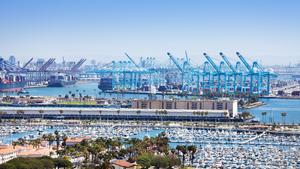The supply chain is broken, and there’s no easy fix. What’s contributing to the delays, and when will the situation improve? We’ve tapped furniture industry veteran and longtime editor Ray Allegrezza for a multipart series that unpacks the challenges at hand. In the fifth installment, he sums up why long lead times are nowhere near over—and how the omicron variant is hampering recovery efforts.
It’s long been acknowledged that patience is a virtue. But after waiting upwards of seven months or more for furniture, even the most patient shoppers are throwing up their hands in frustration as they wait for delivery trucks that seem like they’ll never come.
Is there an end in sight—a singular moment when the snarls of the global supply chain will be untangled? Unfortunately, the omicron variant has all but guaranteed the home industry’s frustrations will persist throughout 2022.
If you’ve been keeping up with the previous articles in this series, you know that every major link in the chain had some form of a breakdown last year. Sadly, it appears that the only change to take place on January 1 was the designation of a new year. Our major ports are still congested, struggling to deal with record numbers of cargo vessels backed up, many of which contain furniture. As I write this, 105 ships are waiting for berths at Los Angeles and Long Beach—the highest number ever, according to FreightWaves, a source of data for the global freight sector.
Trucking companies are still behind schedule and scrambling to find enough drivers and chassis to get inventory to retailers. Suppliers, meanwhile, are still pulling out the stops to find workers, source raw materials and rework their numbers in light of ongoing price hikes for labor, logistics and raw materials.
And then the omicron variant entered the picture just in time for the holidays, making a bad situation worse.
Omicron already has the dubious distinction of being the dominant strain here in the U.S., eclipsing the delta variant by mid-December. Currently, the Centers for Disease Control reports that the new strain is responsible for 98.3 percent of all new cases. And while this variant is not as deadly as earlier iterations, it has flooded hospitals across the country and severely challenged an already overworked and outnumbered health care workforce. It has also thinned out the workforce throughout the already strapped-for-labor supply chain.
So, when one considers that all of the speed bumps we faced in 2021 are back again this year, plus the challenge of a new COVID-19 variant that currently seems unstoppable, my honest advice for those waiting for their furniture to arrive would be something like, “Don’t hold your breath, folks.”
Thankfully, the president of the United States isn’t twiddling his thumbs while the supply chain settles. But is it too little, too late? The Biden Administration recently signed an infrastructure bill with a partial goal of improving the trucking component by recruiting new drivers. It hopes to fast-track drivers seeking industrial driver’s licenses, boost registered apprenticeships and concentrate on some 70,000 veterans who may have licensed trucking expertise while in the military. It also plans to launch the Driving Good Jobs initiative, which marks a new partnership between the Departments of Transportation and Labor that will include listening sessions that engage drivers, unions and worker centers to share best practices and promote driver retention.
While these initiatives are to be commended, the scope of the problems is such that we should not expect to see a major turnaround overnight. The pandemic also became a mother of invention of sorts for a global quest of how, if possible, to make the supply chain stronger and more resilient. And much like our industry, there is no one-size-fits-all answer.
Odds are good that some companies will re-examine domestic production. Others may find new iterations of just-in-time production. Some other suppliers may investigate fallback strategies they may dub just-in-case production.
As for me, I confess that my crystal ball is murky. But for all of you patiently waiting for your furniture, one thing is clear: It’s like the proverbial check—it’s in the mail.
Homepage photo: ©Travel Man/Adobe Stock
____________
Ray Allegrezza is the executive director of the International Home Furnishings Representatives Association, which was founded in 1934 to focus on the needs of the industry’s sales reps. An industry veteran with more than three decades of editorial, publishing and marketing experience in the home furnishings sector, Allegrezza was the editor in chief of Furniture Today from 1995 to 2014.




























